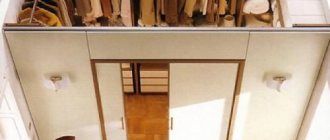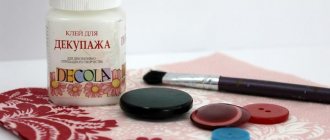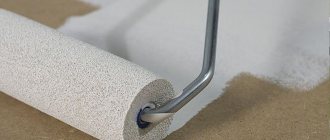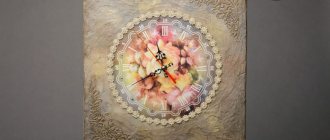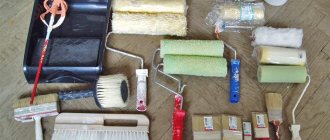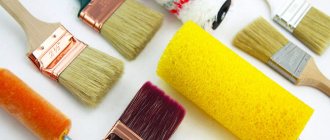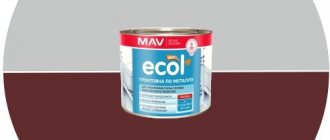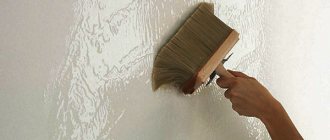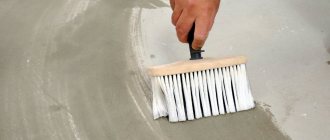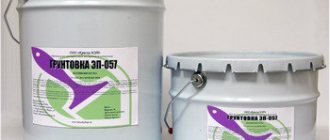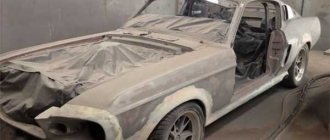Icer
21878 2 5
Icer November 28, 2016Specialization: master in the construction of plasterboard structures, finishing work and laying floor coverings. Installation of door and window units, finishing of facades, installation of electrical, plumbing and heating - I can give detailed advice on all types of work.
In the photo: in order for the decoration to be not only beautiful, but also reliable, you need to properly prepare the base
My wife has been decorating various products for a long time, and I am responsible for preparing the surfaces. Over several years, I have accumulated a lot of experience in priming various materials, which I want to share with you. I will tell you how to make a reliable and durable base for decoupage on different materials for a reasonable price.
The advantage of this decoration option is the ability to work on any type of surface, including metal and wood.
Plastic and glass are complex substrates that are important to prepare correctly
Can I prime with regular paint?
You can prime it with any regular primer, but is it worth it? If you prime acrylic paint, you will get it wet through and there is a huge chance that your paint will swell or rise behind the roller as you paint.
Interesting materials:
How long does defrosted cheesecake last? How long does lard last in brine in a jar? How long can Stewed meat be stored in a jar? How long does liquid nitrogen last in a Dewar flask? How many kilograms of cabbage grows per 1 square meter? How many kilocalories are in 100 g of pearl barley? How many kilometers is the Crimean Bridge? How many kilometers is Planet Earth in circumference? How many kilometers are in one parallel? How many kilowatts does the hob use?
Overview of the main primer options
All bases are divided into two groups: absorbent and non-absorbent. While almost any primer fits perfectly on the first type of surface, the second requires a special approach and conventional primers cannot be used.
Ceramics are prepared very differently from wood or cardboard
Option 1 – wood preparation
We will deal not only with wood, but also with products based on it: fiberboard, chipboard, MDF, etc. All these materials are processed in the same way, so we will analyze them together. I won’t talk about special artistic compositions, since the price for a 50 ml bottle is 150 rubles or more, which is too expensive, there are cheaper options, and we’ll look at them:
150 rubles for 50 grams of soil is too expensive
- The “Sonnet” primer composition is intended for decoupage and decoration, but unlike other similar options, it is noticeably cheaper; for a half-liter jar you will pay about 320 rubles. It has its advantages: elasticity and good adhesion; but there are also disadvantages: if you need to sand the surface, it will not be easy to do, since the composition rubs off very poorly. In general, the option is not bad, but the cost is still high;
Not a bad solution, but there are cheaper options
- Personally, I most often use high-quality acrylic paint as a primer; it has good adhesion to wood and creates a uniform base; an additional advantage of this option is that the surface is very easy to sand. If necessary, the paint can be tinted to the desired color, which is also very important. As for a specific option, I like “Snezka Eco”, a hypoallergenic composition that is inexpensive - about 120 rubles per liter;
A very good option for preparing surfaces for decoupage
- Now I will tell you how to make a primer for decoupage with your own hands. The composition is suitable for wooden and other surfaces that need to not only be strengthened, but also made waterproof. To work, we will need acrylic construction paint and PVA glue, for the first layer the components are mixed in a 1:1 ratio, for the second and subsequent ones you can add a quarter of glue to three parts of paint.
Paint and PVA glue allow you to create a primer of increased strength
Surface preparation is carried out in the following sequence:
- The material is thoroughly cleaned of dust and dirt; if there are any uneven spots, they must first be puttied;
- The first layer of the composition is applied, here it is important to apply the coating to all areas to be finished in an even layer;
- After the first layer has dried, be sure to apply a second one to achieve the best result.;
- If necessary, the layer is leveled with fine sandpaper, after which you can begin decorating.
The base color can be any
Option 2 - preparing leather and fabric
If you are working with fabrics, leather and other flexible materials, then ordinary paint will not work, since the layer will crack when bent, so in this case the following compositions are used:
To decorate such surfaces, special preparation is required.
- Artistic acrylic paints are well suited for such purposes; they not only fit perfectly on the surface, but also create the basis for the color we need (the choice of shades is huge). They are sold in small tubes or jars with a capacity of about 100 ml and cost about 100-150 rubles per package, depending on the color and manufacturer;
You will find any shade you need for the job.
- Special fabric paints are also great; they can be used not only for painting the material, but also to create a base for decoupage. They are sold in sets of 6 to 20 colors or in individual 50 ml tubes. The cost of one package is about 100 rubles;
Special composition will allow you to achieve the best results
- Finally, you can use the Sonnet primer, which I talked about above. Its adhesion and elasticity are exactly what is needed for fabric, leather and other flexible materials.
Any piece of fabric can be turned into a picture using decoupage
The workflow in this case looks like this:
- The material is cleaned of dust and dirt; if you have fabric, then it can be washed; if it is leather or leatherette, then you can wipe the surface with alcohol to degrease it;
- A primer is applied to the dried surface, the work is done with a brush; the smaller the surface to be finished, the less a brush is needed. Try to distribute the soil evenly so that there are as few streaks as possible. ;
It is important to treat the leather or fabric evenly
- After the first layer has dried, the second is applied, which will be the final stage of preparation before decoration.
Option 3 – preparation of glass, ceramics and plastic
These materials are distinguished by the fact that they do not absorb compounds, so it is not worth treating them with ordinary primers and paints - the layer will crack and come off, and very quickly. To prime the surface, you will have to use an integrated approach.
Using decoupage you can transform ordinary glass jars beyond recognition
| Material | Recommendations for selection |
| Aerosol paint | It is this type of composition that fits perfectly on glass, plastic and tiles and ensures high-quality surface preparation. There are both colored and colorless options (varnishes), so if you do not need color, choose the appropriate composition. The cost of a can with a capacity of 400 grams starts from 200 rubles, it lasts for a long time |
| Acrylic paint | To give the base a rich color, it is better to use regular paint as a finishing layer; if everything is done with an aerosol, then the consumption will be high. Paint allows you to quickly cover the surface and give it the desired shade; in addition, decor fits much better on such a base |
| Degreasing agent | Spray paint is very demanding on the quality of the surface, so the base should be thoroughly degreased. To do this, use any solvent, acetone or alcohol. It doesn’t matter what is used, the main thing is to clean the surface well before work and dry it |
Aerosols are great for preparing smooth surfaces
There is another option that is suitable for smooth surfaces - this is the Tikkurila Otex primer, it is sold in cans and applied with a brush.
This option is worse than aerosols for the simple reason that the brush will leave streaks on the surface in any case, so you will have to additionally sand it, while when applied from a spray can the surface will be smooth. In addition, this type of composition takes much longer to dry, which can also be considered a disadvantage.
This composition is suitable for all smooth surfaces
Some people recommend walking over the surface with fine sandpaper before applying primer to glass or ceramics. But you don’t need to do this, if you degrease the material well and apply the primer correctly, it will stick perfectly.
Let's figure out how to prime glass:
- First of all, the surfaces are washed with water and detergent; it is important to remove all contaminants;
- Then it is necessary to degrease the bases, for this a solvent or alcohol is used, a small amount of the composition is applied to a napkin and all surfaces that will be decorated are wiped with it;
It is important to prepare the material very well
- First, the first layer of primer is applied; to do this, the can is shaken and placed approximately 30 cm from the surface, after which you need to press the sprayer and move it so that the surface is covered with an even layer . If you keep the cylinder in one place, smudges will occur;
Gently press the dispenser and apply the mixture evenly to the surface
After processing, the element must dry, this takes no more than half an hour
- A second layer of primer is applied from a container; it is better to walk quickly twice than to walk slowly once and cause smudges. It is important for you to treat the entire surface; the layer thickness may be small;
- After the second layer has dried, paint is applied, this is done with a brush or a piece of foam rubber. After application, the element must be left to dry; if necessary, the treatment is repeated again. .
Applying the composition with foam allows it to be distributed evenly
Option 4 – preparation of metal surfaces
Metal itself is a good basis for decoration, but the material’s tendency to corrode complicates the work process. If you have a new product, then the work is simplified; if the old one has traces of rust, then you will have to work to properly prepare it.
We need the following materials:
- Anti-corrosion primer not only creates a good base for decoupage, but also serves as a kind of barrier to the occurrence of rust. It is available in both cans and cylinders. The second option is preferable for the simple reason that it is much easier to apply and it dries faster, but it also costs more, a 400 g container costs from 200 rubles, and a liter jar will cost from 300 rubles;
Aerosol packaging is much more convenient than the regular version
- To degrease the surface, a solvent or alcohol is needed; without this, you should not apply the composition to the metal;
Acetone is great for degreasing
- For products that have pockets of corrosion, be sure to use a rust converter . I usually use Tsinkar, which is popular among motorists, and it costs little; an aerosol package with a capacity of half a liter costs 170-180 rubles. It is easy to apply and the layer dries quickly enough.
Corrosion areas must be treated with a special agent
Now let's look at the workflow, the instructions for doing it look like this:
Each step in the scheme is important
- First of all, you need to remove all dirt; the easiest way to do this is to wash the surface with water and detergent. You need to remove everything that can be washed off with water;
The surface must be thoroughly cleaned
- If there are pockets of rust on the surface, they must be removed; for this, a metal brush or sandpaper is most often used. It all depends on the scale of the problem, choose a specific option yourself;
Do not leave loose areas of rust, the converter will not remove them, but will only cover them, and corrosion will continue to occur inside.
- The converter is applied in a thin layer to the surface, after which the product should be left until completely dry;
- The surface is degreased, everything is simple: wipe the surface with a cloth soaked in solvent and wait until it dries completely;
- The primer is applied last, everything is done simply from an aerosol, and if you have the composition in a jar, then it is best to distribute it using foam rubber. Most often, you need to treat the surface in two layers so that the color is uniform over the entire area. It is important not to apply too much of the composition, otherwise you will end up with smudges that will have to be removed later.
Applying primer is a simple process
If you need to give the product a certain color, you can apply paint instead of a second layer of primer. The process is similar to that described above, and the main thing is to achieve good coverage, and this requires application in 2-3 layers .
Almost any paint can be applied over the primer
The final result depends on what composition you apply to the surface
Features of the use of compositions depending on the types of surfaces
All materials used as a basis for finishing can be divided according to the degree of permeability. This is a determining factor, so it is difficult to say right away which primer for decoupage will be better. The composition spreads evenly onto absorbent materials and penetrates inside. For these, ordinary universal products are suitable. It is quite problematic to work with smooth bases, so it is better to choose compositions from the range of artistic primers. In this case, a more professional approach will be needed.
In fact, any surface can be decorated. Experienced needlewomen manage to do decoupage even on wax candles. First you need to select an object for decoration and determine its affiliation, that is, what type of material it belongs to. Surfaces accessible to primer penetration include:
- genuine leather;
- MDF;
- tree;
- unglazed ceramics;
- textile:
- cardboard.
The group of non-absorbent materials includes:
- plastic;
- glass;
- metal;
- polymer clay;
- shells, stone;
- glazed ceramics.
Incompatibility of the base with the soil often leads to deformation of the scenery. Sometimes newcomers to this type of creativity try to create products from scrap materials. Initially, such items may look good. But later, under the influence of external factors, the decoupage napkin can form folds, and the seemingly well-dried composition will begin to peel off.
Let's consider which compositions correspond to which type of material used.
Compositions for smooth materials
For such foundations, artistic means are most often used, less often construction ones. In this case, the primer is expected to provide high-quality adhesion of the treated base to the acrylic paint. Such means include:
- aerosol soils:
- artistic compositions;
- building enamels and primers;
- paints.
To decorate metal and glass, only special primer is used for decoupage. For the first, you can use GF-021. This is a universal composition; it has proven to work well with metal due to its high binding properties. It is best to use anti-corrosion agents for this material. Construction compounds intended for metal processing can be purchased at a special store.
Characteristics and properties of a quality product
Creative lovers do not always purchase primers for decoupage in art stores. Often, acrylic paints are used for such purposes, which are available at any construction site. After all, what is important is not what will be taken as a basis, but what the final result will be. The primer for decoupage must meet the following criteria:
- A high-quality composition has a uniform consistency; there should be no lumps or clots in it. Otherwise, you will have to spend a significant part of your time sanding the product. This is a process in which drips, gaps and all the characteristic features of the object that serves as the basis for decoupage are eliminated. For example, if you need to create an imitation of stone or porcelain on a wooden surface, then you need to completely change its texture.
- The next properties that you should pay attention to are ductility and density. The choice of soil according to these criteria depends on the master himself. Some of them like to work with thick formulations because they allow for better coverage. If necessary, they can be diluted with water.
- It is also important how strong the smell of the product is. After all, you will need to work with it for a long time, and caustic and aggressive compounds have a detrimental effect on health. If you focus on this factor, then it is better to choose acrylic primer for decoupage.
Primer for decoupage: types, properties, application features
Decorative and applied art is a field of activity in which materials play an important role: varnishes, paints and primers. One of the most interesting popular areas where the use of these compositions is required is decoupage. Using this technique, various household items are decorated, from dishes to furniture. How the decorated product will look in the end and how much time this painstaking process will take will depend on the quality of the working surface. For this purpose, art stores offer special primers for decoupage from different manufacturers. Let's review the most popular ones, and also consider how you can prepare them yourself.
Decorating bottles
Glass jars or bottles should not be treated with ordinary paints and primers. Over time, the layer will begin to crack and move away from the surface. Most often, an integrated approach is used to finish such products.
First, the base is degreased with alcohol or solvent. Then spray paint is applied. It can be transparent or colored. To enhance the tone, the last layer is covered with acrylic paint - this way you can save varnish.
A transparent composition intended for car repairs can also be used as a primer for decoupage bottles. If you use varnish-glue, then you need to apply two layers - this way the paint adheres better.
What can replace the Decoupage card?
How can you replace decoupage cards
that are sold in the store? The first and probably the cheapest material is ordinary napkins, the same ones that are always present on your dining table. Previously, I usually bought plain napkins, very rarely with any kind of pattern.
Interesting materials:
What does the roll contain? What affects the image quality of a monitor? What kind of company is Ormatek? What kind of material is ranfors? What is the 504 Gateway Time Out error? What is error code 503? What kind of VK subscription combo? What font is this? What are those blue arrows on the labels? What kind of fabric is Anti-claw?
The role of soil
The soil greatly simplifies the work process and performs a number of necessary functions. First of all, it has high adhesive properties, due to which it adheres well to the surface. It also ensures reliable bonding during subsequent paint application. If the base is non-absorbent, then this ability of the composition is simply necessary (for example, ceramics, metal, glass, plastic).
What other purpose is primer used for? Let us highlight its main advantages:
- the composition levels the working surface;
- significantly saves paint volume;
- whitens the base intended for decoration.
LiveInternetLiveInternet
—Categories
- (419)
- KNITTING (330)
- hat (36)
- jacket (16)
- knitting patterns (12)
- socks (4)
- crochet hat with decor (4)
- knitting on a fork (1)
- knitting by machine (1)
- DECOUPAGE (373)
- master class photo (103)
- pictures for decoupage (73)
- The best works of masters (66)
- expert advice (55)
- imitation (43)
- images (37)
- watch (29)
- backgrounds (15)
- photo frame (10)
- “Khokhloma” in decoupage (7)
- outline painting (6)
- decoupage ambientato (stage) (6)
- download book, magazine (5)
- link to Italian site (5)
- Easter eggs (4)
- lamps (4)
- deco patch (3)
- YUMMYS (280)
- from vegetables (40)
- baked goods (37)
- His Majesty GINGER (25)
- economy dish (21)
- with spinach (17)
- from cottage cheese (17)
- sauces (16)
- chicken (11)
- cream soup (9)
- made from meat (9)
- cakes (9)
- yeast dough pies (8)
- her majesty TURMERIC (7)
- dishes for son-in-law (7)
- Swiss chard (6)
- pumpkin (6)
- from liver (6)
- fish (5)
- pates and pastes (5)
- cinnamon to help with weight loss (4)
- His Majesty WALNUT (4)
- prepared from processed cheese (4)
- buffet (3)
- rolls (3)
- warm salad. peak season (3)
- her majesty ASPARAGUS (3)
- vegetable pancakes (3)
- pumpkin (3)
- cauliflower (2)
- cabbage (2)
- from Jerusalem artichoke (2)
- ginger sauce for lamb (2)
- homemade mayonnaise (2)
- his majesty AVOCADO (2)
- bread (1)
- CREATIVE (260)
- decoupage (128)
- OWL OWLS (16)
- burlap (15)
- papier-mâché (13)
- collar (12)
- cuff bracelet (11)
- from napkins (10)
- patchwork (10)
- from plastic bottles (8)
- “Collage” technique (6)
- aging (5)
- made from natural materials (3)
- beautiful font (2)
- glowing helium (2)
- video cutting out a stencil (1)
- cover for passport, book, notepad. (1)
- from newspapers (1)
- DECOUPAGE FOR FURNITURE (219)
- stencils (64)
- master class (56)
- everything for updating furniture (50)
- decoupage tricks (21)
- we restore furniture (17)
- foil (9)
- coffee table (8)
- HEALTH (177)
- for health with your own hands (46)
- products for a healthy life (27)
- to preserve youth (21)
- exercises FOR MUSCLES (18)
- acupuncture points (10)
- elixir of youth (9)
- health seasonings (9)
- pneumonia (4)
- fat burning cocktail (4)
- high blood pressure (3)
- super stretch exercises (3)
- insomnia (1)
- double chin exercises (1)
- VINTAGE (167)
- cardmaking (56)
- image transfer (18)
- hearts (6)
- Old Years Happy New Year Cards (4)
- leaf skeletonization (3)
- Happy New Year cards (3)
- CUT AND SEW (125)
- tailoring (27)
- (17)
- sewing video tutorials (14)
- pattern (12)
- (6)
- leather (5)
- cosmetic bags (4)
- storage (3)
- hats (2)
- link to site (1)
- apron for bottle (1)
- GIFT IDEAS (113)
- dolls (34)
- cakes with sugar fondant (10)
- dough figures (9)
- gift packaging (3)
- Family tree (2)
- HOME DESIGN (109)
- pillows (24)
- shabby chic in the interior (15)
- angels (13)
- lavender (10)
- use of lace in New Year's decoration “Yolo (5)
- FIGURE (93)
- drawing with children (14)
- painting “One Stroke” one stroke (7)
- download book (4)
- snowmen (3)
- painting on fabric (1)
- ARTISTIC DECOUPAGE (PITTORICO) (88)
- box (40)
- Polish decoupage (12)
- video (11)
- PSYCHOLOGY (80)
- thoughts and desires (18)
- problems with children (6)
- Bazi..studying our destiny (3)
- blowing soap bubbles. (2)
- calculator "Bazi" (1)
- 7 LAWS by Randy Gage (1)
- TREATMENT (68)
- treatment with folk remedies (58)
- mustard plasters (1)
- salt dressings for diseases (1)
- soda for many diseases (1)
- PHOTO (55)
- Photoshop and Paint.net lessons (17)
- FASHION (48)
- my favorite style (23)
- bags (13)
- making a wardrobe (3)
- MUSIC (44)
- CRAFT WITH YOUR OWN HANDS (41)
- costume jewelry (19)
- steampunk (2)
- folding chair (1)
- COUNTRIES (38)
- Italy (10)
- France (6)
- Belarus (3)
- Tricks of Life (37)
- reminders (13)
- cook quickly (6)
- ORDER IN THE HOUSE (37)
- housewife tips (8)
- storage (6)
- Household assistant - ammonia (3)
- STAINED GLASS PAINTING (32)
- draw a contour on the glass (18)
- stained glass painting video (2)
- for table (2)
- SKIN CARE (31)
- face masks (14)
- homemade cream (2)
- recipes with sea salt for the body (1)
- USEFUL IN EVERYDAY (28)
- DISPLAY DISPLAY (26)
- FOREIGN LANGUAGES (26)
- French (11)
- Italian (10)
- English for children (1)
- INTERIOR (24)
- HAIR (24)
- 2014 - Year of the Horse (19)
- HOW TO Cope (17)
- with stain (8)
- with negative energy in the house (3)
- with mold (2)
- with furniture bug (1)
- CUP CAKE IS A POPULAR SWEET IN MILAN (11)
- recipes (4)
- very elegant cupcakes (4)
- cupcake labels (2)
- (11)
- COMPUTER (10)
- video (2)
- LINKS (10)
- payment (1)
- RELIGION (10)
- Orthodox Calendar for 2013 (1)
- DECOUPAGE "sospeso trasparente" (9)
- video (5)
- CARTOON PEPPIE LONGSTOCKING (9)
- Pippi Longstocking doll pattern (4)
- master class on making a textile doll (3)
- draw Pippi (2)
- TIPS for Li.Ru (8)
- Download video (2)
- (8)
- (1)
- OUR LITTLE BROTHERS (7)
- AUTUMN (6)
- autumn leaves in composition (4)
- GARDEN AND VEGETABLE VEGETABLE (5)
- growing leaf beets (1)
- ITALIAN CUISINE,LIGURIA (4)
- Ligurian pesto (1)
- EMBROIDERY (4)
- carpet equipment (1)
- BLANGES (3)
- PRODUCTS VIA THE INTERNET (3)
- PARABLES (2)
- ITALIAN CUISINE, PIEMONTO (2)
- bagnetto verde (1)
- PANCAKES (1)
- filling (1)
- WATCH MOVIE (1)
- KARAOKE (1)
- Fortune telling online (1)
- (1)
- NAIL CARE (0)
-Music
—
—unknown
—Search by diary
—Subscription by e-mail
—Interests
— Regular readers
-Statistics
Types of compositions
When it comes to decoupage, not only artistic compositions, but also construction paints, in particular acrylics, act as a primer. Of course, special primers are convenient to use. But sometimes the needlewomen themselves prefer to choose ordinary construction materials. For example, paint forms a porous layer that is easy to sand. During the grinding process, it is cleaned off in the form of fine dust, and the surface becomes perfectly smooth.
It is believed that professional products have better adhesion. How can a novice master understand the types of compositions? Paints and primers for decoupage are distinguished according to several criteria.
Firstly, they are divided according to their production purpose: artistic and construction. Secondly, by the type of surfaces used for decoupage. They are permeable and non-absorbent.
Briefly about decoupage
Decoupage is a type of applied art that uses the technique of gluing cut-out illustrations, patterns, compositions and other elements. At the last stage, such work is varnished. The name of this art form means “to carve” in French. The decoration process itself is to give naturalness to fragmentary images. A thin layer is removed from the paper cutout and glued onto the object, thereby creating a certain depth and making the picture look as if it had been painted.
As with any DIY project, creating a truly aesthetically pleasing piece requires a well-prepared foundation. To properly treat the surface, you cannot do without high-quality primer for decoupage.
For gluing
To glue decoupage motifs, a special decoupage glue is used, a cheaper analogue of which is ordinary PVA glue (which, however, does not give the same effect of leveling the motif and does not hide the difference between the glued fragment and the surface when re-applied).
In addition, fragments can also be glued using a glue stick (volume ones - a gun), egg white, office glue, etc.
For decoupage on fabric, you can only use special textile glue, although experienced craftswomen have learned to work with acrylic varnish.
